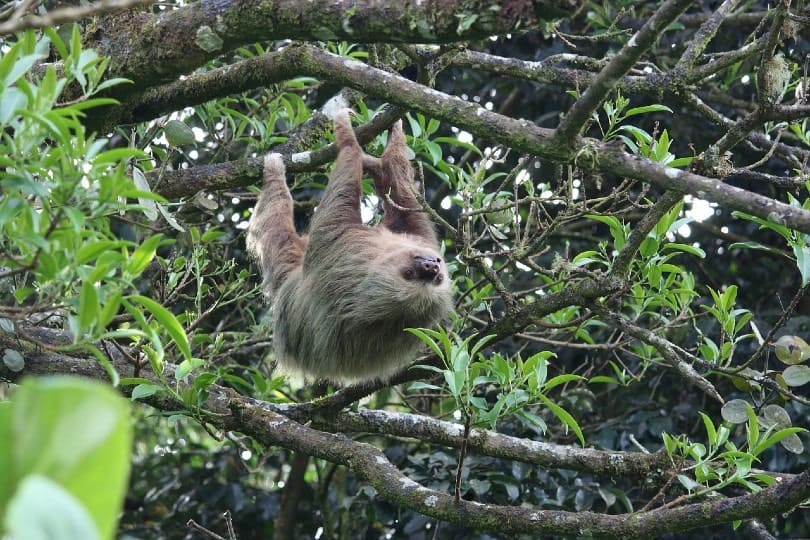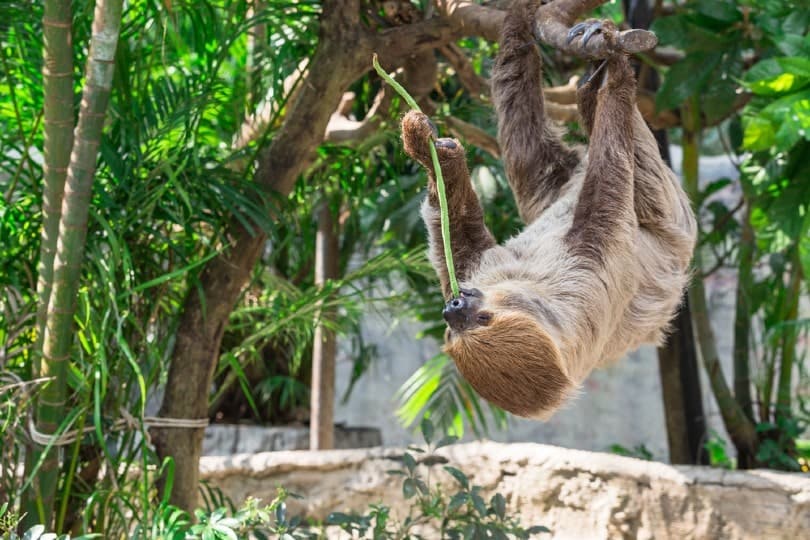Sloths are mysterious animals that have grown in popularity in recent years due to the fact that they’re adorable. However, while many people might love these cuddly little critters, few know much about them.
This includes basic information like what they eat, where they live, and how they fit into the world. Since sloths are herbivores, they eat mostly leaves and fruit. If you’re curious to learn more about these strange creatures, this article will walk you through the high points.

Where Do Sloths Live?
Sloths are found in the tropical rain forests of Central and South America. They spend most of their days high up in the trees — sleeping, to be exact. They spend 15 to 20 hours a day snoozing, and the rest is usually spent munching on food that they find in the canopy.
There are actually six different types of sloths, including two- and three-toed varieties. Some are critically endangered, while others still have a healthy number of individuals in the wild.
The biggest factor threatening their existence is deforestation. They’re completely dependent on their environment for survival, so as the rain forests get thinned out, so do the sloth populations.
Sloths are famously slow, and it could take them all day to travel 40 yards or less. Interestingly enough, they’re fantastic swimmers and often move faster in water than they do on land or in the trees.

What Do Sloths Eat?
Sloths primarily eat leaves and fruit, although they’ll also snack on juicy green shoots when they can find them.
They’re primarily herbivores, but they have been known to munch on insects and bird eggs when they can find them. However, given the fact that they’re not the speediest creatures in the world, they’re not mighty hunters. Any meat that they eat needs to be equally slow and easy to catch.
The reason these animals are so lethargic is that they have incredibly slow metabolisms. Their metabolism is about 40% of what you’d typically expect of an animal their size, and because they don’t move fast (or much at all), they don’t consume enough calories to be more active.
In terms of water, they get most of their moisture from the fruits that they eat, although they will also lap dew off leaves.
What Eats Sloths?
Sloths have a few predators, including jaguars and eagles. These animals enjoy snacking on sloths because they’re slow and easy to catch, although they’re mostly preyed upon when found on the jungle floor rather than in the trees.
They also have to worry about anacondas and other massive snakes, but again, they’re only likely to be eaten by those animals when they’re slowly wandering along on the ground.
They do have a few defenses against predators, including their long claws. They also snack on poison ivy to make themselves unappetizing, but that usually doesn’t save them; instead, it merely harms the animal that ate them after the fact.
Their biggest defense against predation is their algae-covered fur, which makes them difficult to spot in dense foliage.
Humans are among the most capable predators of sloths, as they’re often hunted for meat by people living near the jungle. However, they’re somewhat hard to hunt because shooting them in the trees has little effect. Instead of falling to the ground once shot, they merely hang lifeless from the branches, their claws refusing to let go even after death.

What Is the Sloth’s Role in Their Ecosystem?
This is a bit of a tricky question to answer because sloths actually are an ecosystem.
Their bodies are hosts to various algae and insects, including beetles, cockroaches, and moths. In fact, some of the animals that live on sloths are endemic to them, meaning that they can’t be found anywhere on Earth other than on sloths.
Sloth poop is also important to biodiversity in their environment. Sloths leave the trees to poop on the ground, exposing themselves to predation, but they do it for a good reason.
The moths that live on sloths lay eggs in their poop, and the poop needs to be on the ground for the eggs to hatch and grow. Once the moths hatch, they return to their sloth hosts, bringing nutrients with them from the ground, and these nutrients are essential for the algae that grow on the sloths and protect them from predators.
Can You Keep a Sloth as a Pet?
That depends on where you live. Owning a sloth is legal in some places and requires special permits in others. In certain places, it’s strictly forbidden, however, so consult your local laws before bringing one home.
Even if it’s legal to own a sloth where you live, that doesn’t make it a good idea. While these animals are docile and agreeable, it’s difficult to provide them with an environment similar to the one that they’re accustomed to.
Such an environment would have to be truly massive, and most people aren’t capable of providing that kind of space. They also poop frequently, and both sloth poop and sloths themselves smell terrible.
What’s more, it’s next to impossible to find a vet who’s experienced with sloth care. There may only be a few in your entire country, much less in your immediate vicinity, so if the animal becomes sick, you’ll both be in bad shape.
Forget taking vacations as well. You won’t be able to find a pet sitter with experience taking care of sloths, and there won’t be any boarding facilities in your area. You’ll have to spend most of your time at home, with your smelly, lethargic, tree-dwelling pet.

Are Sloths Dangerous to Humans?
Sloths aren’t generally known for being aggressive — they simply lack the energy to be antagonistic. That doesn’t mean they can’t defend themselves if threatened, however.
They have extremely long, sharp claws and equally formidable teeth, and they’ll use both to protect themselves if put into a corner. They can do serious damage with those things, and you do not want to be on the receiving end of an attack.
It’s unlikely that a sloth would kill a human, and there are no recorded instances of a sloth-related fatality. However, keep in mind that these animals are self-contained ecosystems, and that means their claws and saliva are both packed with bacteria. You could easily get a serious infection from a sloth-related injury.
For the most part, though, sloths are agreeable creatures, and as long as you don’t pose a threat to them, they’re unlikely to harm you. It’s best not to take the chance, however.

The Slow, Surprising, Sensational Sloth
Sloths are incredibly interesting creatures, and they can be fascinating to watch even if you’re not enthralled by their cute and cuddly appearance. They’re truly unlike any other animal on Earth.
While their diet may not seem that interesting on the surface, their ability to coexist with various other unique organisms makes them of incredible interest to scientists in multiple disciplines.
You may also be interested in:
- What Do Armadillos Eat? Everything You Need to Know!
- What Do Salamanders Eat in the Wild and as Pets?
Featured Image Credit: Studio concept, Shutterstock
